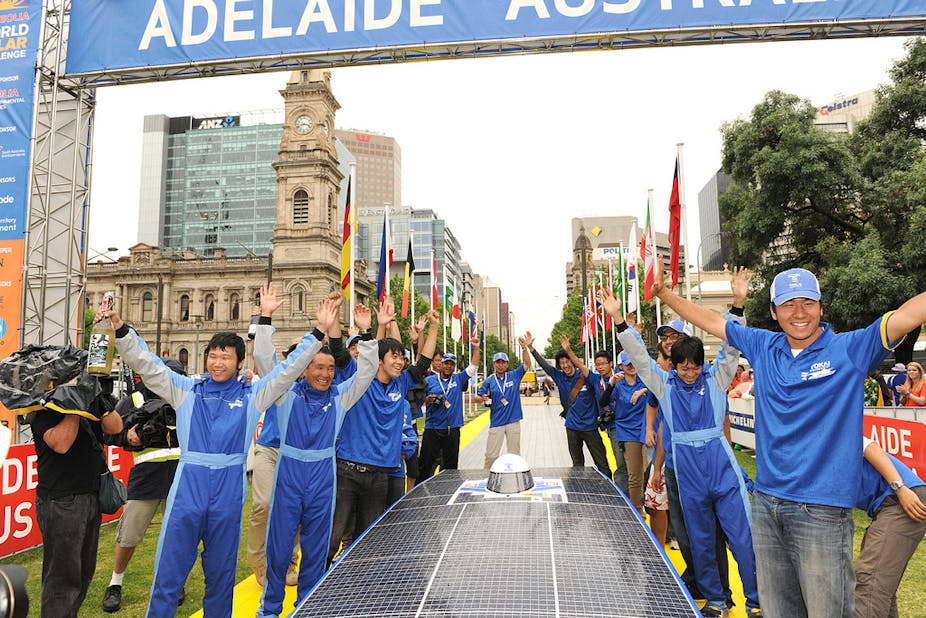On October 20 2011, the Tokai Challenger solar car drove quietly into Victoria Square in the centre of Adelaide, winning the 2011 World Solar Challenge.
The car had crossed Australia from north to south in five days, with an average speed of 91.5 km/h. In the next two days, six more solar-powered cars rolled into Adelaide having completed the 3,000 kilometre trek from Darwin.
The World Solar Challenge began in 1987 and since then 11 challenges have been held. Every couple of years teams from around the world come to Australia with the aim of crossing the continent in a car powered only by sunlight.
There are a handful of rules that teams must follow, including:

- the area of the solar collector is limited to six square metres
- energy storage is limited to five kilowatt hours (enough energy to run a hair dryer for three hours)
- teams may drive for only nine hours each day
- the first team to reach Adelaide is the winner.
This year’s World Solar Challenge was particularly gruelling. On the second day, bushfires near Barrow Creek – 1,200 kilometres south of Darwin – closed the Stuart Highway, delaying the cars by almost four hours.
When the highway reopened, smoke, dust, strong winds, heavy cloud and rain continued to hamper the cars. Thirty cars did not make it to Adelaide within the allotted time.
Since 1987 the performance of the leading cars has steadily increased. In that first year the GM Sunraycer completed the event with an average speed of 66.9 km/h.
Recent changes to race regulations – designed to keep the cars below the highway speed limit – have reduced the allowable area of solar collectors from eight square metres to six square metres. The new regulations also require a more upright seating position for the driver, increasing aerodynamic drag.
Despite these changes, the top cars can still drive over 700 kilometres per day at speeds approaching highway speed limits.
So why aren’t we all driving solar-powered cars? And are we ever likely to see solar-powered cars cruising around our city streets?
Solar racing cars are highly specialised machines, designed specifically to carry a single person along a highway as efficiently as possible, using energy from sunlight.
There are important trade-offs between performance and practicality:
Solar cars must be as light as possible, to minimise the rolling resistance of the tyres. A good solar car will weight about 150 kilograms, compared to 1,500 kilograms for a typical passenger car.
Solar cars do not have comfortable, adjustable seats, interior trim, sound-deadening material, entertainment systems, or air conditioning.
They are built using expensive low-mass materials, including carbon fibre and titanium.

- Solar cars must have low aerodynamic drag. The shape of the car is designed for efficiency rather than for the comfort of the driver.
The driver is typically seated on the floor of the solar car body, in the centre or towards the rear of the solar panel. The driver’s head is usually enclosed in a bubble not much larger than their motorcycle helmet.
The driving position is cramped. Getting in and out of a solar car usually requires the driver to climb through a small opening.
- Solar cars use expensive photovolatic cells, to get as much power as possible from the allowable collector area.
High-efficiency photovoltaic cells, with efficiencies greater than 22%, can cost hundreds of thousands, or even millions, of dollars. The need for a large, flat solar collector means solar cars are typically longer and wider than conventional cars.
Solar cars use expensive lithium ion or lithium ion polymer batteries, to maximise energy storage efficiency and capacity.
Most solar cars carry only one person.
Solar cars are designed for efficiency rather than practicality, and use less than one tenth of the energy of a modern electric car. If you wanted to drive a conventional car 700 kilometres in a day, powered by sunlight, then you would need 60 square metres of collector rather than six.
Unless you want to drive a car that’s 40 metres long, it’s not going to happen.
Despite the differences between solar racing cars and more practical conventional cars, the technology developed for solar racing is playing, and will continue to play, an important role in developing more efficient vehicles:
The low-mass materials and construction techniques used for solar cars can be used to build low-mass practical vehicles that will use considerably less energy than conventional cars.
Principles of aerodynamic-drag-reduction used in solar cars can be applied to conventional cars, and will be increasingly important as vehicle mass is reduced.
Motors designed specifically for solar cars have peak efficiencies greater than 98%. The same techniques can be used to design more efficient motors for electric vehicles and for other applications.
The highly-efficient motor controllers and photovoltaic panel controllers developed for solar cars can be applied to more practical electric vehicles and to general photovoltaic systems.
The World Solar Challenge remains an important test bed for efficient battery configurations and battery management systems.
But most importantly the students, engineers and enthusiasts who design, build and operate solar cars gain a deep understanding of the importance of energy efficiency and how it can be achieved.
These are the people who will shape our future.

